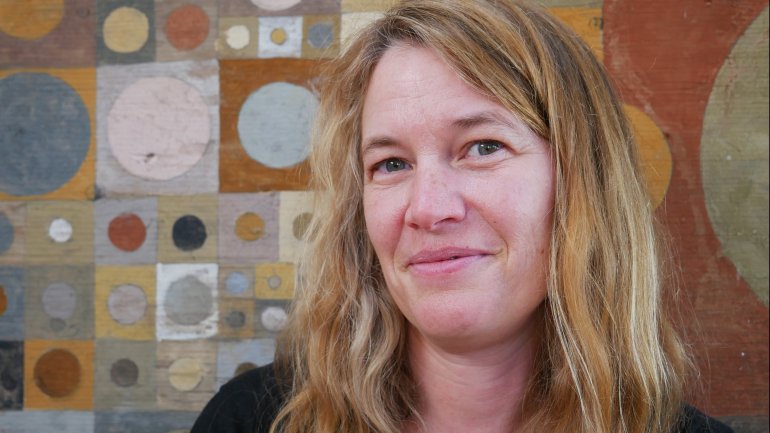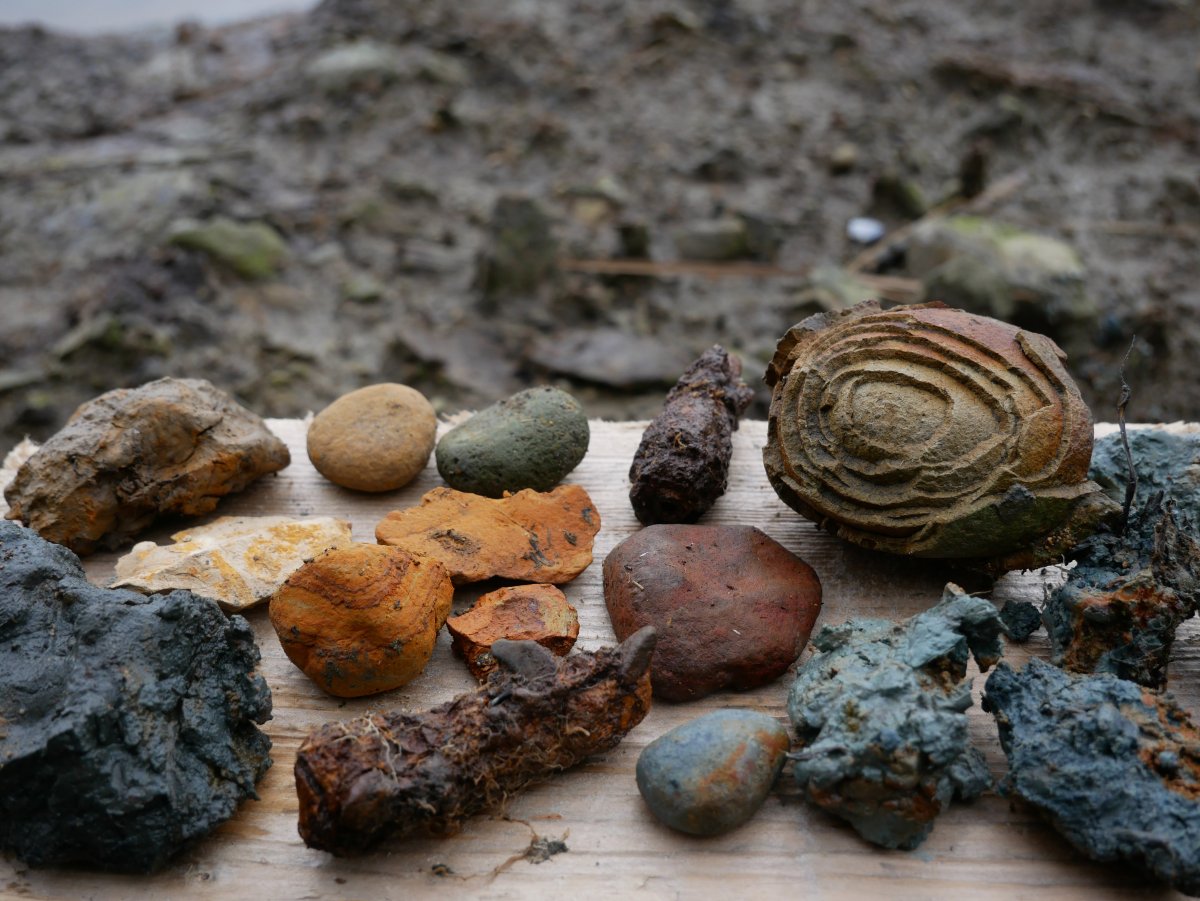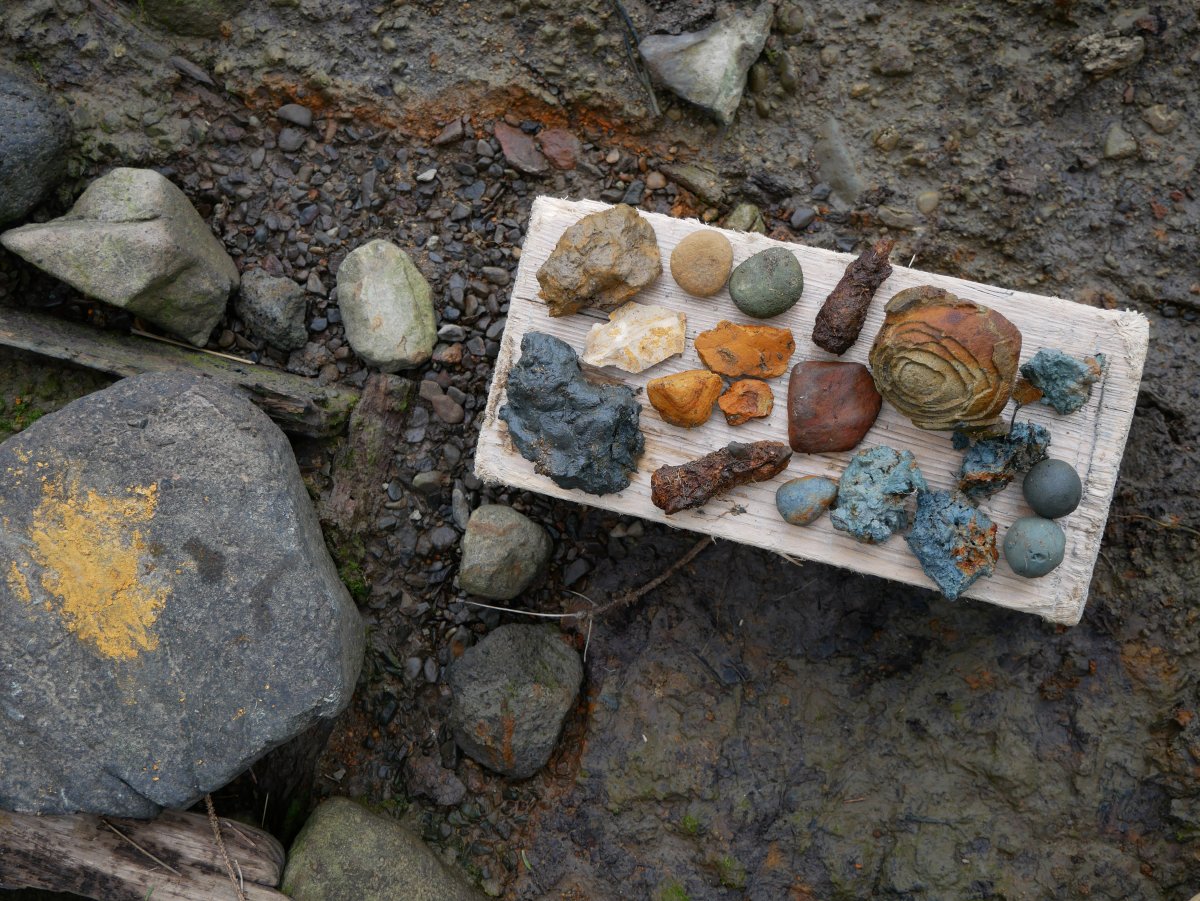The Queue: Tilke Elkins
Get to know the people featured in the pages of our magazine as they share what's inspiring them right now.

Tilke Elkins in front of her painting Ceremony for Being With Nechesni. Photo by Tilke Elkins.
Tilke Elkins sees wild possibilities in wild pigments.
Tilke Elkins’s practice is grounded—literally—in place. The Oregon-based writer, artist, researcher, and educator has been making paint since childhood. “At the time, I thought I was just pretending to make paint,” she says. “If only someone could have told me I was doing the real thing.” Since 2008, she has worked with wild pigments, foraged colorants originating from mineral and botanical sources. With deep reverence for the land and its traditional stewards, she makes paint—and then paintings—with these pigments, using waste objects as her canvas. In 2019, Elkins founded Wild Pigment Project, which invites artists—including textile and ceramic artists—to share pigments and the stories and culture around them through programs such as the Ground Bright pigment subscription series and the monthly newsletter Pied Midden. Shannon Stratton wrote about her work with Wild Pigment Project in “Origin Stories” in the Summer 2023 issue of American Craft.
How would you describe your work or practice in 50 words or less?
My pigment practice is a conversation about revolution and healing through embodied relationship-building with all beings. I call wild pigments “homeopathic doses of revolution” for the paradigm-shifting behaviors these dusts can initiate: reciprocity, regenerative economics, anti-racism, equity between species, Land Back, collaboration over competition, and the legitimizing of intuition.
Tell us about your first encounter with pigment in the wild. How did you use it?
Right after college, I visited the Ochre Pits of the Western Arrernte people in Australia’s Northern Territory with my travel-writer parents. Back home, I scraped the fine silt off the tops of puddles on a red dirt road, mixed it with gum arabic, and made my first watercolor of place with place.
What are your favorite tools in your tool kit, and how do you use them?
Rocks. They’re an original human tool and they’re still useful now. I arrive at my painting sites with nothing more than a paintbrush. Soft rocks are my pigments. Flat and rounded rocks act as mortars and pestles. Really flat rocks work for mulling. Even rocks that don’t look much like tools can be useful if you find their one flat edge. My industrially produced paintbrush serves as a bridge between geological deep time and the hectic extractive human world, giving me the easy precision I need to render the sharp edges of my inherited visual language.

Ochre-rich clays on the banks of the Salmon River, Oregon. Photo by Tilke Elkins.
Can you highlight some of your favorite projects and artworks created with pigments from the Ground Bright pigment subscription program?
Elaine Su-Hui—founder of Inner Fields, a social practice project building a culture of generosity and ecological wisdom—has made exquisite, mandala-like paintings with the full set of Ground Bright pigments. Poet and painter Daniela Naomi Molnar’s New Earth series incorporates the Ground Bright pigments into renderings of exposed shapes left by receding glaciers. Ink alchemist Thomas Little uses his contributed pigments, made with firearms dissolved in sulfuric acid, to collaborate with slime mold, creating exquisite networks of iron-carrying mycelial matter.
You publish a monthly newsletter called Pied Midden, which features interviews with wild pigment artists and researchers. Tell us about your favorite conversations.
A set of two interviews with Ngāti Awa / Ngāi Tūhoe / Ngāti Pūkeko artist Sarah Hudson, co-founder of the pigment research collective Kauae Raro, about contemporary pigment practices in Aotearoa (New Zealand) and the concept of being a good guest as a forager has been formative for me. I’ve also learned a great deal from conversations with Awabakal / Wonnarua / Bundjalung artist Melissa Ladkin about ochre protocols and reciprocal relationships with land. Textile artist and researcher Lucille Junkere offers potent reflections on the legacy of colonialism in African Caribbean textile history, and I was recently moved by a group interview with artist Heather Bird Harris, Atakapa-Ishak historian Jeffery U. Darensbourg, and wetland ecologist Ashley Booth about the rapid disappearance of the Louisiana coast. My ongoing dialog with Northwest Coast pigment researcher Melonie Ancheta continually informs my thinking.

Tilke Elkins, 2023, Ceremony for Being With Nechesni, mineral pigments found and prepared on-site, flotsam driftwood, 49 x 36 in. Photo by Tilke Elkins.
Which craft artists, exhibitions, or projects do you think the world should know about, and why?
For me, the presence of materiality and skill as a feature of emotive and conceptual work signals an irrelevance to distinctions between art and craft. There’s a lot of pigment stuff happening this summer: form & concept's Wild Pigment Project group exhibition goes to NMSU’s University Art Museum with pigment sets, all the Ground Bright pigments, and work by more than a dozen of us pigment artists (June 22–September 16). Another group pigment show, Feeding the Unseen: Remediations of Earth, curated by Heidi Gustafson and Devon Deimler, runs June 3–July 30 at the Philosophical Research Society in Los Angeles. On July 22, WPP will launch the Pigments As Catalysts online talk series. The online Pigments Revealed Symposium 2023 is June 21–24, with a focus on sustainable pigment practices. I’ve got my eyes on the Kauae Raro Research Collective’s ongoing pigment knowledge sharing, and the just-launched C.R.A.F.T. (Centre for Retrofitting and Failure Techniques), planning a net-negative energy, wild pigment-centric printmaking studio on Hupacasath lands. Plus three new pigment books are coming out this year: Book of Earth by Heidi Gustafson, Found and Ground by Caroline Ross, and Gathering Colour by Caitlin ffrench. Other artists working with wild pigments to follow: painters Athena LaTocha, Ka’ila Farrell-Smith, and interdisciplinary artist and kapa maker Lehuauakea.

Want to learn more about all of the craft artists you love?
Become an ACC member to receive a complimentary subscription to American Craft magazine and gain complimentary access to our shows, travel deals, and more!






